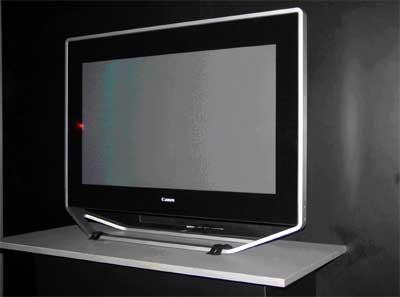SED: A New Player in the Flat-Panel Game

Canon's prototype 36-inch, 720p SED panel.
Just when you thought you had figured out the differences between plasma, DLP, and LCD technologies well enough to make a reasonably informed purchase of a large-screen TV, in steps a new player. SED is the name of a display technology being developed by Canon and Toshiba. It stands for surface-conduction electron-emitter display (a type of field-emission display). An SED panel can be thought of as a cross between a traditional CRT and a plasma panel, since it is essentially a humongous array of tiny CRTs! That's right, good old electrons being fired - the "electron emitter" part - at good old red, green, and blue phosphor dots.
In contrast to a CRT, however, an SED has separate electron beams for every pixel (three beams, in fact, one for each red, green, and blue subpixel) all under the control of digital signal processing. You might envision a tiny electron gun each aimed at a single spot of color and activating that spot alone. Since an SED is a panel, with a total panel thickness of less than 8 millimeters in the prototype that was on exhibit, the electrons don't have to travel very far. And since there's a separate electron emitter for every subpixel, there's no need for the beam-steering deflection yoke of a CRT.
If you think this sounds vaguely akin to the cell-like construction of a plasma display panel, you are correct. But the similarity stops about there. The pixels in a plasma panel are inherently digital devices that have only two states, on and off. A plasma produces gradations of light intensity by changing the rate at which each pixel produces its own series of very-short, equal-intensity flashes.
In an SED, on the other hand, the electronics are mostly digital but the display itself is analog: a pixel glows continuously with an intensity directly proportional to the strength of the electron beams hitting its color phosphors. This operating principle has several very significant implications for a video screen.
The most obvious is improved contrast ratio. When a pixel is supposed to produce pure black, it turns off entirely. There's no leakage from the backlight as in an LCD, no stray light from the deflected beam bouncing around the inside of a DLP display, and no pixels accidentally discharging light bursts as a plasma set tries to maintain all its "black" pixels in the primed, almost-ready-to-flash state. And the one-beam-per-color-subpixel construction means that the phosphors can be driven very hard without causing the resolution-degrading "blooming" that tends to occur in the brightest areas of a CRT image. Toshiba and Canon representatives, speaking of the actual 55-inch, 1080p panel that the companies will introduce separately midyear in Japan, specified a contrast ratio of 100,000:1. Even if subsequent testing reveals they are exaggerating by a factor of ten, that would still be a significant advance. It would place SED far ahead of not only LCD, DLP, and plasma displays, but even film and photographic prints.



























































